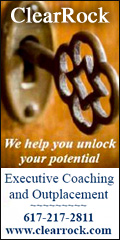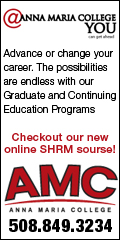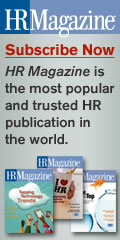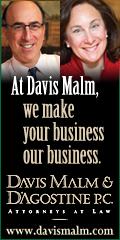NEHRA News
Northeast Human Resources Association
"In absence of clearly defined goals, we become strangely loyal to performing daily acts of trivia." — Author unknown
Successful Professionals have three commonalities:
- Know their value add—what they have to offer
- Know what they want—goal oriented
- Know how to ask for it!
Annual goal setting will allow you to achieve the following outcomes:
- Mission for your career
- Specific goals you want to accomplish both personally and professionally
- Plan with direction for execution
- Criteria for accountability
The following five-step process can help you stay on target and achieve the kind of success you envision for yourself. It will enable you to drive your career in the direction you aspire to as well as to be open to unexpected opportunities exploring new paths and directions.
Step 1: Identify Vision, Mission and Values
- Vision – current and future
- Mission – existing and ideal
- Core Values – what matters most
Step 2: Create SMART Goals
Specific – precise and quantifiable rather than vague
Measurable – appropriate metrics to qualify success
Attainable – realistic, challenging and achievable
Results-Oriented – focus on desired outcomes
Time Bound – specific target dates for completion
Step 3: Develop Goal Setting Process
- Short term goals – 1 to 3 years
- Long term goals – 3 to 5 years
- Realistic obstacles and challenges
- Execution strategy – what, how and when
- Follow up plan to review and evaluate
Step 4: Determine Commitment
- Identify written personal/professional goals
- Reach out to others for help and support
- Gain cooperation from others involved
- Commit to staying focused and true to yourself, live more intentional life
Step 5: Maintain Accountability
- Revisit, reassess and reevaluate goals on a regular basis
- Make adjustments as appropriate
- Continue to formulate process of setting your personal and professional goals
If you reflect on 2011, were there missed opportunities as a result of not having set goals for the year? Did you hold back your career by not identifying specific goals that you wrote down and reviewed monthly for progress? A few years ago, there was a Harvard Business School Study that researched their graduates over a 30-year period and found that written goals can translate into earnings of 10 times more than those who fail to establish goals or put their goals in writing! Another study conducted by Dominican University over a period of a month (on short-term goals) concluded that those who wrote down their goals with specific action steps and follow up fully realized their goals at a rate of 50% more than those who did not.
"Our goals can only be reached through a vehicle of a plan, in which we must fervently believe, and upon which we must vigorously act. There is no other route to success." — Pablo Picasso
As you begin 2012, establishing your goals is an effective way to clarify your vision and set the stage for success. It takes resilience and commitment to stay true to ourselves. Organizations strive to attract the right mix of talent, develop them and keep them engaged to fulfill their business goals and objectives. Each individual can have a plan that empowers themselves to take charge of their careers and ensures alignment within organizational and functional goals. Enjoy the process, set yourself apart and push yourself out of your comfort zone as you kick off the year 2012!!!
Rita Allen is the President of Rita B. Allen Associates, a provider of career management/talent management consulting and coaching services located in Waltham at www.ritaballenassociates.com and the President of ACPI – NE (Association of Career Professionals International – New England), a strategic partner of NEHRA, www.acpi-ne.org.
There are several steps to creating an effective recruitment program:
- The first starts with the basics: the job description. Many organizations only have job descriptions without specific expectations spelled out. It’s very difficult to describe a position to a candidate, without having it completely defined. It's important to detail the expected job performance outcome, and be very specific in what is needed and expected. The job description should have 30-, 60-, 90- and 180-day objectives, so the candidate has a clear understanding what is expected for the job. Be sure to review and update job descriptions regularly, as organization needs and expectations for a position are bound to change.
- The next step is to define where to recruit candidates or target your recruiting process. Now that you have an idea of what you need and expect for the position, where do you find this treasured person? There are many resources: Referrals, recruiters, newspaper ads, college placement centers, .com listings, etc. Referrals are usually one of the best sources for candidates and giving out the job description to business associates and friends may reveal the perfect candidate. When working with recruiters, it is very important to be as specific as possible to avoid your time being wasted with unqualified candidates. According to Arnie Winkler of the Northwest Public Power Association, "Organizations must be specific in understanding what they want in technical competency, cultural fit and behavioral characteristics." The same is true for ads so that the ad is as definitive as possible. College placement centers are not only good for recruiting college grads, but usually have facilities to list positions that require extensive experience too. They can be especially helpful if they are in close contact with the alumni association.
- Soon in your hiring process, you will be faced with a big pile of resumes. Look for resumes that are specific to your needs and notice the presentation style, which will tell you a great deal about the candidate. It is helpful to decide what the priorities are for the position and look for those first in the resumes.
- Once you have settled on a few resumes, we suggest the two step approach to interviewing. The first is the telephone interview, which can save you valuable time and effort. Ask the candidate a set of specific questions, such as: Why are you interested in this position? Please describe three key attributes that you have to offer to our company? Give me one significant program that you had an impact on in the last six months? Listen carefully to the candidate to see if the response fits the job description. This process allows the candidate to earn a face-to-face interview.
- When interviewing in person, it is important to listen and not let emotions take over. The candidate should talk about 80 percent of the interview and the interviewer only 20 percent. The goal for interviewing effectively is to note their thinking patterns, and not get caught up in appearances, impressive schools or companies. During the interview, questions that are more specific are helpful in making successful hiring decisions. Some examples are: What significant impact have they had at three or more companies on their resumes - ask for specifics, percentage of change; Please describe in detail what brought about the change; What was their process, from A to Z?and ask how the candidate would handle a specific problem that you have seen in the position.
- Once a candidate has been selected to be hired, then the most difficult part of the hiring process begins: reference checking. Many firms find professional organizations helpful when making background checks.
- Yet, as the old saying goes, "You never know someone until you work with them, travel with them or live with them." Through in-depth work style and personality testing, you can reduce the possibility of making a hiring error. An in-depth assessment can be like a MRI to identify inner traits of a candidate if the appropriate assessment is selected.
When researching profiles, here are some things to keep in mind:
- Training or degrees required for interpretation of the data. Weekend training programs can be problematic since testing and human behavior is a very complex subject. When making hiring or internal decisions, organizations need as much understanding as possible as the consequences can be very costly.
- A copy of the resume should be supplied to the testing company to review when discussing the assessment results. We suggest to make sure that they require this as part of the process so it is used when reviewing the assessment results.
- Scale for "Impression Management" to understanding accuracy of results and if someone is trying to ‘fake good’. The questionnaire needs at a minimum of 164 questions to gather enough data for this scale.
- Number of studies conducted and there should be multiple studies for validation purposes.
- How long has the profile been used—what is the history.
- How often is the normative database updated and where is the data coming from. (For example, U.S. Census)
- Cultural bias – is it built into the profile and for which countries.
- Does the profile meet U.S. government employment standards? Has it been reviewed for ADA compliance & gender, culture and racial bias?
- Reading level required (5th grade English, etc).
- Number of profiles administered.
- Number of actual primary scales as defined by the "Big 5" testing standards. Many tests will claim to have more scales than they actually have - this can lead to misrepresentation of data.
- Validity, reliability and basis.
A common inquiry from companies and organizations is about the legal guidelines in providing assessments to candidates. Since industries vary, it is always best to check with a trade association or a legal representative. The general rule is that a test or any set of hiring questions needs to be administered to all final candidates in order to assure that discrimination is not taking place. More information may be found at the EEOC website, in the Disability-Related Inquiries and Medical Examinations of Employees section:
http://www.eeoc.gov/policy/docs/guidance-inquiries.html#2
Another question is how do new hires usually feel about taking an in-depth, work style assessments. It shows that a company is serious about who they hire. If the company presents the testing program as a method of assuring both parties that they are making the right decision, the individual usually responds very well. The bottom line is that hopefully turnover is greatly reduced.
In-depth work style and personality assessments can be very helpful for personnel development and succession planning. As a hiring tool, they can be used to develop additional questions for interviewing and confirming the interviewer's intuition that might be overlooked. This process gains more reliable and accurate data in order to effectively manage individuals to make hiring and personnel decisions a win-win for everyone.
As a special gift... just click the following link and you will receive a list of telephone and face to face interview questions:
http://www.lighthouseconsulting.com/Articles/KOTInterviewQ/signupform.php
If you are a hiring manager and would like to see a sample of an in-depth work style and personality assessment profile, please call or email us. For more information, please contact Dana Borowka at Lighthouse Consulting Services, LLC, (310) 453-6556, extension 403, or email at dana@lighthouseconsulting.com.
As you have seen, a successful hiring program requires many components that work together to provide the needed information for difficult personnel decisions. Combining a well-defined job description, targeted recruiting and focused interviewing with an effective in-depth work style and personality evaluation program, turns hiring into a profitable and rewarding process.
Permission is needed from Lighthouse Consulting Services to reproduce any portion provided in this article. © 2012.
If you would like additional information on this topic or others, please contact your Human Resources department or Lighthouse Consulting Services LLC, 3130 Wilshire Blvd., Suite 550, Santa Monica, CA 90403, (310) 453-6556, dana@lighthouseconsulting.com and our website: www.lighthouseconsulting.com.
Lighthouse Consulting Services, LLC, provides a variety of services, including in-depth work style assessments for new hires and staff development, team building, interpersonal and communication training, career guidance and transition, conflict management, workshops, and executive and employee coaching. To order the book, "Cracking the Personality Code," please go to www.crackingthepersonalitycode.com.
If you know of an individual or company that deserves this award, nominate them today by CLICKING HERE.
Thank you for your nominations!
- To become a fan of NEHRA on Facebook, CLICK HERE.
- If you are already a member of LinkedIn, CLICK HERE to join the NEHRA LinkedIn Community!
If you are not already a member of LinkedIn, you will need to follow the easy steps to create your profile. Once your profile is completed you can follow the steps below to become a member of the Northeast Human Resources Group.
- Find the tab for "Groups" on your home page and select "Group Directory."
- Use the search function in the upper right and type in "Northeast Human Resources Association."
- Click on "Join this Group."
- This will bring you to a description of the group and you will be asked to make selections about your preferences for display the group logo on your personal page.
- Enter a contact email address, a digest e-mail address, delivery frequency, announcements and messages.
- Once you have made these choices click the button "Join Group."
- Your message will come to the NEHRA Group Administrator to verify membership and approve you for the group.
To Join a Community Forum Subgroup on LinkedIn
- Once you are a member of the Northeast Human Resources Group, select "Subgroups."
- Select all the groups you are interested in joining.
- Your request goes to the NEHRA Group Administrator for approval.
- You will receive a message that you are a member of this subgroup and you can begin to read and post information on the Subgroup page.
Current NEHRA Subgroups
- Learning and Development Community Forum
- Diversity and Inclusion Community Forum
- Consultants Community Forum
- Small Business HR Community Forum
- HR Technology Community Forum
- Talent Acquisition Community Forum
- Flexible Workplaces Community Forum
As you may know, NEHRA is continuing to evolve to better meet the needs of members. Therefore, we have created a new membership category: Group Membership.
This category is created to recognize the need, and often the desire, of many organizations to control spending and manage membership expenses for their employees.
What does this really mean for you? It means that if your company has five or more current members, you could experience a savings of 10 percent or more on the total cost of these NEHRA memberships through Dec. 31, 2011. In addition, the group membership allows you to renew all memberships at the same time—reducing the hassle and workload of individual renewal dates. Finally—and perhaps most importantly—it ensures that all members of your team have access to programming, to our new webinars, to resources and information at our website and to networking and professional development opportunities.
- How does the program work? All current members from your organization are renewed on a pro-rated basis—based on the individual membership type (NEHRA or NEHRA/SHRM), to bring them to a common renewal date, Dec. 31. Any new members are added and pro-rated, based on a Dec. 31 end date. The entire group is then renewed for another full year, based on this common renewal date.
- Can I add new members? New members can be added to your group at any time during your membership cycle, and their membership will be pro-rated to maintain them on the single renewal date.
- What if someone leaves? You can easily transfer that membership to another employee within your team, with one quick call.
- How does the membership work? Each group member is assigned an individual membership number, allowing them to access information on www.nehra.com and to register for events, webinars and professional development throughout the year.
This is an exciting new opportunity for you to expand access to NEHRA and save money!
If you are interested in learning more about the group membership or getting a quote for your group, please contact Carole Edson, Director of Membership and Alliances, at (781) 239-8705 or cedson@nehra.com.
It will also ensure that your information is correct in the Member Directory.Once you log in, go to the "About NEHRA" tab and selectMembership Directoryand then click on Update My Membership Profile.
While you are updating your profile, you might want to consider joining one of the Community Forums or adding your name to one of the Listservs.An updated profile and connecting to one of the NEHRA Communities is a great way to maximize your membership and create your personal network.
If you need help with this process please do not hesitate to contact Carole Edson, Director of Membership, at cedson@nehra.com.
For more information or to sign up for this opportunity, contact the NEHRA office today at (781) 235-2900 or via email at info@nehra.com.
The companies or Employment Partners benefit by outsourcing a full-time, entry-level, professional job to one team of four students who share the job. The NDHS student workers are an innovative resource that enables organizations to increase their diversity and to make a real impact on the workforce of the future without adding to their roster of full-time employees. Many Employment Partners really value the energy that the student workers bring to their companies.
As NDHS continues to grow, the CWSP seeks additional Employment Partners for our students. To learn more about the CWSP and how it can benefit your company, please go to www.ndhslaw.org/corporate-work-study-program.



